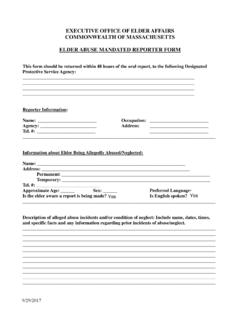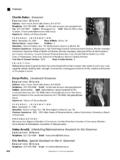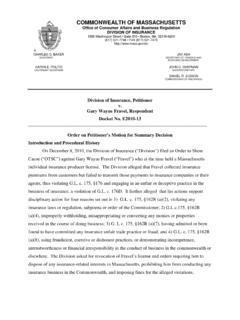Transcription of Southeastern Massachusetts - MassBenchmarks
1 Massachusetts BENCHMARKSSUMMER 16 .. Historically, Southeastern Massachusetts has beendefined by its five cities Attleboro, Brockton,Fall River, New Bedford, and Taunton whosecommon industrial history extends back to the early cities have risen and declined along with the fortunesof traditional manufacturing industries, such as textiles andapparel and metals fabrication. In the late 1920s, when thetextile and apparel industries left the state, the cities wentinto a long period of 1920 and 1990, the populations of NewBedford and Fall River dropped by approximately 20 per-cent. Since the end of World War II, each of the region scities has experienced a pathology of de-industrialization: lowincomes, high unemployment, low rates of educational at-From the FieldSoutheastern MassachusettsBuilding a New Economytainment, decaying municipal infrastructure, population loss,low property values, and a weak tax Search of a SolutionThe region s identity has long reflected its economic, po-litical, and geographic isolation.
2 During the 1980s, it con-tinued to experience high unemployment rates, low in-comes, and population loss, despite a full employmenteconomy statewide and income growth that was the high-est in the Concerned that residents were not ben-efiting from the Massachusetts Miracle, the region s fivemayors established the Southeastern Massachusetts Part-nership in concerns were reinforced shortly after theCLYDE BARROWThe Southeastern corner of the Commonwealth flourishedduring the industrial age, but for most of the past century, itscities and towns have been in decline. With employment,education, and general economic conditions paling in com-parison to state averages, there was nowhere to go but studies and an influx of funds have begun tolay the groundwork for 2002 Massachusetts 17 ..partnership s establishment,when the region s cities beganlosing jobs at a pace not seensince the Great Depression.
3 Theentire state followed Southeast-ern Massachusetts into the 1990 91 recession and, by its trough, Southeastern Massachusetts hada regional unemployment rate of12 percent. Some of its cities re-ported unemployment rates inexcess of 20 response to the crisis, theSoutheastern Massachusetts Part-nership sponsored the first com-prehensive study of the region seconomy, drawing explicitly onthe framework developed byMichael In 1991, thepartnership released The HighSkills Path for Southeastern Massachusetts : A Framework forDecisionmakers, and convened a conference of regional lead-ers to discuss its findings. The study defined SoutheasternMassachusetts as five counties Bristol, Plymouth,Barnstable, Dukes, and Nantucket though it recognizedthat many other plausible definitions could be advanced,based on federal planning districts, labor market areas, ser-vice delivery areas, and state administrative study s main conclusion was that policymakers,business executives, and educators would need to attendto underlying structural problems in the regional economybefore efforts to attract or retain businesses could be suc-cessful.
4 These structural problems included low educationalattainment and a modest base of higher-education institu-tions that was not adequate to support technological inno-vation or technology transfer. The study called attention to the critical importance of human capital in the neweconomy, which in Southeastern Massachusetts was notadequate to sustain the knowledge-intensive service indus-tries and high-technology manufacturing that has supportedthe state s last two economic Choosing to Compete,5 the state s Executive Officeof Economic Affairs, in collaboration with the Universityof Massachusetts , narrowed the working definition of South-eastern Massachusetts to 40 towns and cities in Bristol andPlymouth Counties. The region s boundaries were rede-fined in response to demands from Cape Cod residents thatthe Cape and Islands be treated as a separate region.
5 Infact, the Cape s unique tourism-based economy warrantsthis modification for statistical and planning TheMassachusetts EOEA s redefinition of Southeastern Mas-sachusetts also established new geographic boundaries thatwere more consistent with those of the Southeast Regional Southeastern Massachusetts : Population by Town, 1990 and 2000 City or Town19902000 Numerical PercentageChange ChangeTop Gains:Taunton49,83255,9766, ,60851,7016, ,56822,4145, ,24925,1853, ,26518,0363, Losses:New Bedford99,92293,768-6, River92,70391, ,5584, ,5228, Region Total949,5201,015,84366, : Bureau of the CensusPlanning and Economic Development District and the OldColony Planning Council, which assist communities withtransportation and land use regional analysis of Southeastern Massachusetts inChoosing to Compete identified significant business clustersin textiles,7 electronics and communications, marine scienceand technology,8 food processing, metals fabrication, fish-ing,9 and The report concluded that despite itseconomic difficulties, the region had several competitiveadvantages, particularly within the northeastern UnitedStates, such as an extensive highway network, lower busi-ness costs, affordable housing, and workforce availability inspecialized industries and occupations.
6 Its main conclusion,however, reinforced the partnership s earlier findings: Thebusiness clusters most likely to anchor the region s futureeconomy including its traditional manufacturing firms had finally started to adopt improvements in technologyand productivity that created a need for enhanced workforceskills and higher levels of educational attainment. Thus,Choosing to Compete concluded that new private investmentin technology and public investment in education, workforcetraining, and technology transfer were the main economicdevelopment priorities in the this period, State Senator Marc Pacheco andState Representative Joan Menard convened the Southeast-ern Massachusetts Legislative Caucus to address many ofthese problems at the regional and state policy level. TheSMLC was established to develop a regional legislativeagenda that would address economic development issues,which cut across the artificial town, city, and legislative dis-trict lines that had often hampered regional economic de-velopment initiatives in the past.
7 The SMLC includes statelegislators from all 48 cities and towns in Plymouth andMASSACHUSETTS BENCHMARKSSUMMER 18 .. Bristol Counties and, thus, includes some South Shore townsthat are members of the Metropolitan Area Planning Coun-cil but were excluded from the Choosing to Compete defini-tion of the SMLC s conferences have been co-sponsored bythe Southeastern Massachusetts Partnership, Southeast-ern Regional Planning and Economic Development Dis-trict, Old Colony Planning Council, UMass Dartmouth,and Bridgewater State College, and have effectively estab-lished a common definition of the region among legisla-tive, planning, and academic institutions for the first , when the University of MassachusettsBenchmarks Project was begun in 1998, it adopted theSMLC definition of Southeastern Massachusetts with onlyminor Boundaries.
8 A Moving TargetThe UMass Benchmarks Project defines Southeastern Mas-sachusetts as the 48 cities and towns in Bristol and Plym-outh Counties, plus Plainville, Stoughton, and Avon inNorfolk County, to accommodate regional planning agencyboundaries. In reality, the definition continues to evolve,not merely because of competing administrative, planning,and data collection jurisdictions, but because the region isbeing transformed by uneven economic and demographicchanges that are blurring many previously accepted bound-aries. The region s pattern of economic development rein-forces the emergence of differentiated subregions, so it isincreasingly recognized that in using any definition of South-eastern Massachusetts , there are economic geographies andsubregional identities that make it difficult to formulate asingle definition of the region that is appropriate for Department of Labor identifies four labormarket areas in Southeastern Massachusetts , including theFall River, New Bedford, Brockton, and Boston.
9 Tauntonand the Route 3 corridor are considered part of the Bostonmetropolitan statistical area, while Fall River and Attleboroare included in the Providence metropolitan statistical Workforce Investment Boards identify four service de-livery areas (SDAs) in Southeastern Massachusetts that areused to deliver employment and training services. The fourSDAs are Greater Bristol (Fall River-Taunton-Attleboro),Brockton Area, South Coastal (Route 3 corridor), andGreater New Bedford. Until 1993, the Cape and IslandsService Delivery Area was part of the Greater New BedfordSDA. The Massachusetts Office of Business Developmentstill identifies Bristol, Plymouth, Barnstable, Dukes, andNantucket Counties as a single service BaseThe Southeast region s three economic areas continue tomake uneven progress in addressing the pathologies of de-industrialization and in making the transition to a neweconomy, but the three subregions are all deep into thistransition.
10 This transition is most notable in the displace-ment of traditional manufacturing by services as a leadingeconomic activity in every subregion. Metropolitan Statistical Areas (MSAs)Boston MA-NH PMSAB rockton PMSAP rovidence-Fall RiverMSANew BedfordPMSAF almouth-Bourne LMAB arnstable-YarmouthMSAM etropolitanSouth/WestSDAB rocktonSDAS outh CoastalSDAB ristol SDANew BedfordSDACape Cod,Vineyard,NantucketService Delivery Areas (SDAs)The Southeast region defies easy 2002 Massachusetts 19 ..ILLUSTRATION: NAOMI SHEAM ajor Employment Sectors in Southeast Subregions2000 2000 Percent of Area s Average Employment EarningsSouth Shore Area $33,121 Services: Allied Health $32,907 Professional $51,560 Business $38,237 Financial $43,662 $14,346 Tri-Cities Area $33,498 Services Allied Health $35,228 Business $25,620 Manufacturing: High $51,550 Metals $40,491 $46,672 South Coast Area $29,162 Services: Allied Health $32,172 Social $20,414 Business $16,500 Manufacturing: Textiles and $26,845 High $42,725 $33,613 Massachusetts Total:n/a$44,329 Source: Massachusetts Division of Employment and Training The South Shore.











